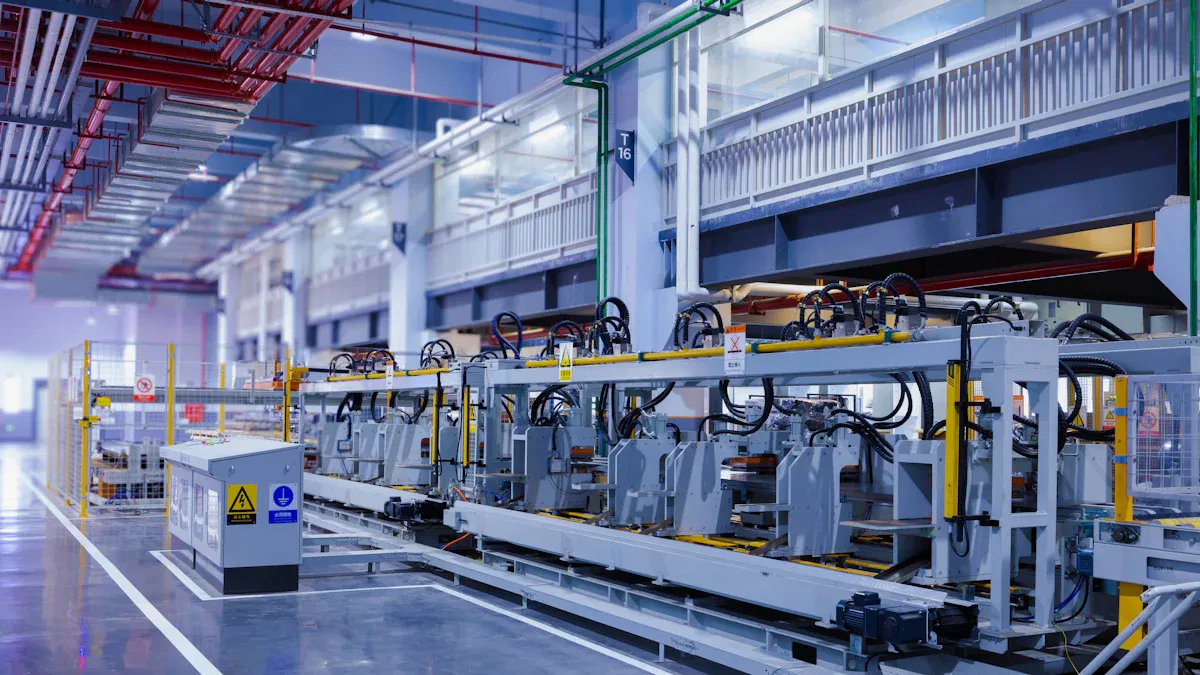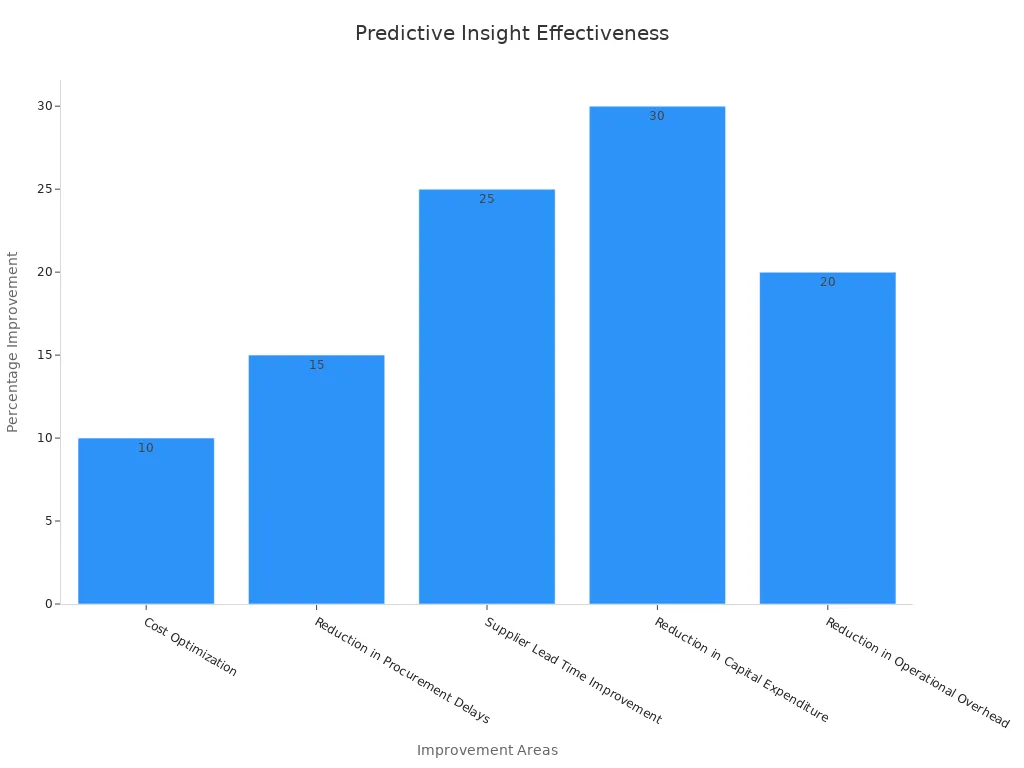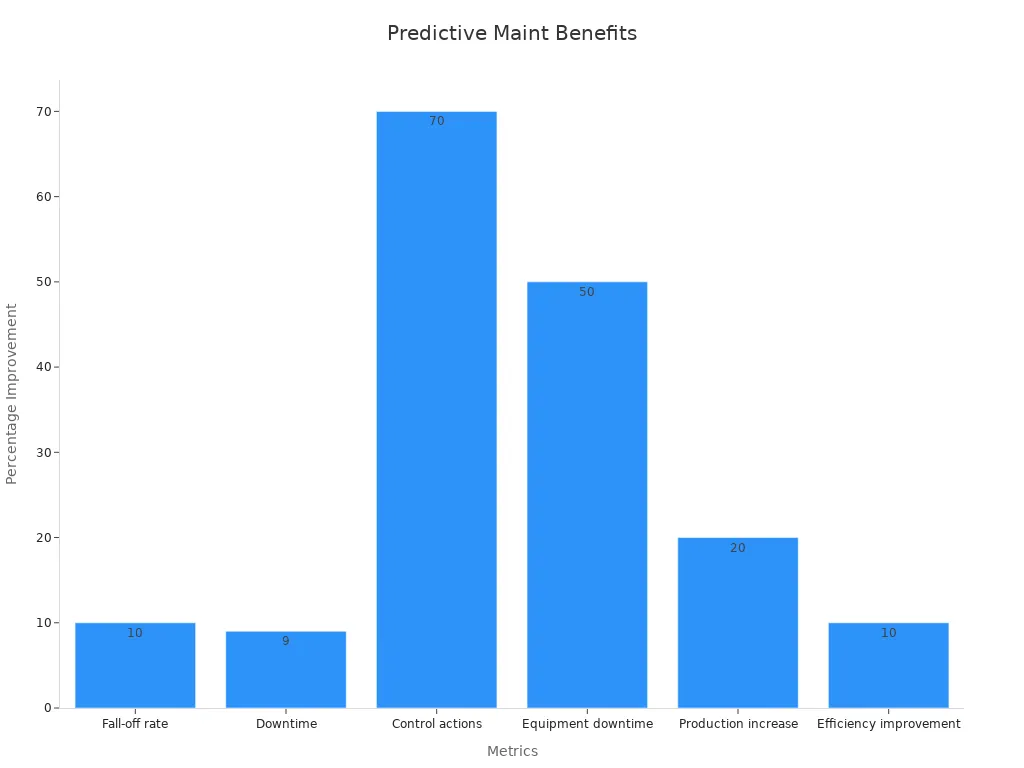
AI is revolutionizing how you manage injection molding machines. With the help of AI-powered systems, you can predict potential failures before they occur. These systems analyze data from your machines and identify issues that might go unnoticed. Predictive maintenance minimizes downtime by scheduling repairs at the right time. It also ensures consistent product quality by reducing defects. For example, real-time monitoring of machine parameters has helped many manufacturers achieve higher efficiency and lower material waste. By adopting AI, you can optimize performance and save costs.
Predictive maintenance uses advanced tools like AI to monitor equipment and predict when failures might occur. Instead of waiting for a machine to break down, you can address potential issues before they disrupt production. This approach relies on data collected from sensors that track parameters such as temperature, vibration, and pressure. By analyzing this data, AI-powered systems can identify patterns and detect early signs of wear or malfunction. For injection molding processes, predictive maintenance ensures machines operate efficiently, reducing the risk of unexpected downtime.
Predictive maintenance is a cornerstone of Industry 4.0, especially for critical components like nonreturn valves. Monitoring these parts can improve process optimization and maintain product quality.
Injection molding machines face constant stress due to high temperatures, pressures, and repetitive cycles. Over time, this wear can lead to failures that disrupt production. Predictive maintenance helps you avoid these issues by providing real-time insights into machine health. For example, IoT devices can monitor essential parameters and alert you to potential problems. Companies like SABIC and INEOS have successfully implemented AI-driven predictive maintenance to reduce downtime and cut costs. This proactive approach ensures your machines stay reliable and productive.
Adopting predictive maintenance offers several advantages for manufacturers like you:
- Reduced Downtime: By addressing issues early, you can prevent unexpected machine failures.
- Improved Product Quality: Monitoring critical parameters, such as melt temperature, ensures consistent results.
- Cost Savings: Proactive repairs are often less expensive than fixing major breakdowns.
- Enhanced Process Optimization: AI-driven insights help you fine-tune operations for maximum efficiency.
Predictive maintenance not only keeps your machines running smoothly but also supports long-term process optimization. This approach allows you to stay competitive in a demanding industry.

Sensors play a critical role in ensuring the health of injection molding machines. These devices continuously collect data on machine parameters such as temperature, pressure, and vibration. By doing so, they provide valuable insights into the machine's condition. For example, sensors can detect subtle changes in vibration patterns, which may indicate wear in mechanical components. This early detection allows you to address potential issues before they escalate into costly failures.
The accuracy and reliability of sensor data are essential for effective monitoring. Sensors not only report real-time data but also help identify problem areas that require immediate attention. This capability enhances your ability to maintain machine health and avoid unexpected downtime. Predictive maintenance relies heavily on this data to understand the state of your equipment and prevent failures. With sensors in place, you can ensure that your machines operate efficiently and consistently.
AI algorithms are the backbone of predictive maintenance in injection molding machines. These algorithms analyze the vast amounts of data collected by sensors and identify patterns that may indicate potential problems. For instance, AI can detect anomalies in temperature or pressure readings that might signal an impending malfunction. By recognizing these patterns early, you can take corrective action before the issue affects production.
Machine learning models enhance the accuracy of these predictions. They learn from historical data and improve their ability to detect anomalies over time. This means that the more data your system processes, the better it becomes at predicting failures. AI-powered systems also provide actionable insights, helping you make informed decisions about maintenance schedules and repairs. This proactive approach minimizes disruptions and ensures that your machines remain in optimal condition.
Real-time quality control is a game-changer for injection molding processes. By continuously tracking machine performance, you can identify and address issues as they arise. For example, production management software can monitor key parameters like melt temperature and injection pressure. If these parameters deviate from the optimal range, the system can alert you immediately. This allows you to make adjustments on the fly, preventing defects and maintaining product quality.
Real-time monitoring also boosts overall equipment effectiveness (OEE). Studies show that such systems can increase OEE by up to 9%, reducing downtime and improving efficiency. Alerts and notifications further enhance your ability to respond quickly to changes in machine performance. Statistical Process Control (SPC) adds another layer of protection by analyzing molding parameters over time. This method helps you identify optimal production conditions and respond swiftly to deviations, ensuring consistent results.
By leveraging real-time quality control, you can maintain a smooth production process and avoid costly interruptions. This approach not only enhances efficiency but also supports long-term reliability in your operations.
IoT sensors are the foundation of predictive maintenance in plastic injection molding. These sensors continuously gather data on critical machine parameters like temperature, pressure, and vibration. This data provides a real-time view of your machine's health, enabling you to detect early signs of wear or malfunction. For example, subtle changes in vibration patterns can indicate potential issues in mechanical components. By addressing these problems early, you can avoid costly breakdowns and ensure smooth operations.
AI-driven predictive maintenance has transformed traditional maintenance practices. By analyzing data collected from IoT sensors, AI systems can foresee equipment issues, reducing unplanned downtime and extending the lifespan of your machines. Companies like Husky have implemented systems such as the Advantage+Elite proactive monitoring system. Using Azure IoT Hub, this system collects real-time data and predicts potential failures. It notifies you in advance, significantly reducing downtime and maintenance costs. Additionally, continuous monitoring from six global centers allows technicians to resolve issues before they impact productivity or part quality.
Tip: Investing in IoT sensors not only improves machine reliability but also enhances your ability to maintain consistent product quality.
Cloud computing and big data analytics play a crucial role in processing the vast amounts of data generated by IoT sensors. These technologies enable you to store, analyze, and access data from anywhere, providing a centralized platform for monitoring and decision-making. By leveraging cloud-based systems, you can evaluate multiple process parameters simultaneously, enhancing energy efficiency and reducing costs.
A study highlights the effectiveness of cloud computing and big data analytics in predictive maintenance. The table below shows the percentage improvements achieved in various areas:
| Improvement Area | Percentage Improvement |
|---|---|
| Cost Optimization | 10% |
| Reduction in Procurement Delays | 15% |
| Supplier Lead Time Improvement | 25% |
| Reduction in Capital Expenditure | 30% |
| Reduction in Operational Overhead | 20% |

Real-time big data analytics also allow you to monitor and optimize your plastic injection molding processes. By analyzing historical and real-time data, you can identify trends and make informed decisions to improve efficiency. This holistic approach ensures that your operations remain cost-effective and sustainable.
Machine learning models are at the heart of AI-powered predictive maintenance. These models analyze sensor data to identify patterns and predict potential failures. Over time, they learn from historical data, improving their accuracy and reliability. For example, predictive maintenance models can forecast equipment failures, helping you schedule repairs before issues disrupt production.
AI-powered visual inspection systems enhance quality control by detecting and classifying defects in real-time. These systems ensure that your products meet high standards, reducing waste and rework. Intelligent process controls, powered by reinforcement learning, optimize molding settings to improve efficiency and minimize material waste. By integrating machine learning into your operations, you can achieve greater precision and consistency in plastic injection molding.
Note: Machine learning models become more effective as they process more data. Regularly updating your systems ensures they stay accurate and relevant.

Predictive maintenance has transformed automotive manufacturing by reducing downtime and improving machine reliability. A case study highlights how monitoring the cooling system in injection molding processes can detect issues early. By integrating data from multiple sources, manufacturers achieved an average error of only 3.29% in predicting mold temperature. This accuracy ensures timely interventions, preventing costly disruptions.
Milacron's M-Powered technology offers another example of success. It monitors machine conditions and predicts component wear. Alerts notify you when maintenance is needed, allowing you to address problems before they escalate. This approach has led to measurable outcomes in automotive manufacturing:
| Outcome | Measurement |
|---|---|
| Reduction in Downtime | 40% |
| Lower Maintenance Costs | 30% |
| Increase in Productivity | 20% |
| Enhanced Equipment Lifespan | Early detection of wear and tear |
| Improved Product Quality | Reduced defect rates |
These results demonstrate how predictive maintenance enhances efficiency and ensures smooth production in the automotive sector.
In consumer goods production, predictive maintenance plays a vital role in maintaining efficiency. By anticipating potential issues, you can schedule maintenance during non-peak hours. This minimizes disruptions and keeps production on track. Manufacturers also benefit from reduced maintenance costs, as unplanned downtime often leads to expensive repairs.
For example, Orbis, a manufacturer of plastic containers, used Milacron’s M-Powered Solutions to monitor machine health. The system provided real-time alerts, enabling proactive maintenance. This approach improved operational efficiency and reduced downtime. Additionally, integrating sensors and AI into production processes optimizes machine settings, ensuring consistent product quality.
Tip: Leveraging predictive maintenance not only saves time and money but also enhances your ability to meet production goals.
Industry leaders have demonstrated the significant benefits of predictive maintenance. By adopting AI-driven solutions, they have achieved remarkable improvements in manufacturing processes. For instance, predictive maintenance has reduced downtime by 9% and increased production efficiency by 10%. The availability of real-time process data has also grown, enabling better decision-making.
| Metric | Improvement |
|---|---|
| Reduction in fall-off rate | 10% |
| Reduction in downtime | 9% |
| Increase in availability of process data | From 20 minutes to real-time |
| Potential production efficiency improvement | 10% |
| Estimated savings for top 100 EU manufacturers | 160 BEUR |

These lessons highlight the importance of adopting predictive maintenance to stay competitive in modern manufacturing.
AI systems rely heavily on high-quality data to deliver accurate predictions. However, ensuring data quality can be challenging. Predictive models require large datasets that reflect real-world operational conditions and potential failure modes. Often, the data collected from process monitoring contains noise, bias, or gaps, which can reduce the accuracy of predictions. For example, incomplete or inconsistent data may lead to false alarms or missed warnings about unplanned downtime.
Integrating data from various equipment and systems adds another layer of complexity. Machines often generate data in different formats and at varying frequencies. This disparity makes it difficult to combine information into a unified system for analysis. Advanced data integration tools can help you overcome these challenges, ensuring seamless communication between devices and systems. By addressing these issues, you can improve the reliability of AI-driven maintenance and reduce unplanned downtime.
Adopting AI-powered systems requires careful evaluation of costs and return on investment (ROI). While AI can reduce unplanned downtime and optimize process monitoring, the initial setup costs can be significant. Expenses include purchasing IoT sensors, implementing cloud-based platforms, and training staff to use the technology effectively. You must weigh these costs against the potential savings from reduced maintenance and improved efficiency.
Calculating ROI involves analyzing both tangible and intangible benefits. Tangible savings include lower repair costs and fewer production delays. Intangible benefits, such as enhanced product quality and better process monitoring, also contribute to long-term profitability. By conducting a thorough cost-benefit analysis, you can determine whether AI adoption aligns with your business goals.
Integrating AI into your operations requires more than just technology; it demands a shift in organizational culture. Training your staff to use AI systems effectively is essential for success. Employees need to understand how AI improves process monitoring and reduces unplanned downtime. Providing hands-on training sessions and interactive workshops can help them adapt to the new tools.
Managing change within your organization is equally important. The ADKAR Model offers a framework for guiding employees through the transition process. This model emphasizes awareness, desire, knowledge, ability, and reinforcement to ensure smooth adoption. Studies show that projects involving AI are more likely to succeed when supported by effective change management strategies. By fostering a culture of learning and adaptability, you can maximize the benefits of AI-powered maintenance systems.
AI-powered predictive maintenance is transforming injection molding by improving machine reliability and efficiency. You can achieve significant cost savings and maintain consistent product quality by leveraging AI-driven insights. For instance, regression-based quality control has reduced defect rates by 35% in automotive plants, while a German manufacturer saved €2.3 million annually by lowering out-of-specification parts from 3.2% to 0.8%. The table below highlights these advancements:
| Evidence Description | Impact | Source |
|---|---|---|
| 35% reduction in defect rates in automotive plants using regression-based quality control | Improved quality control | Johnson & Miller, 2021 |
| Reduction of out-of-specification parts from 3.2% to 0.8% in injection molding | Cost savings of €2.3 million annually | German automotive parts manufacturer |
| 28% improvement in maintenance timing accuracy with regression models | Enhanced maintenance efficiency | Zhang et al., 2022 |
| 92% prediction rate of potential failures in semiconductor fabrication | 64% reduction in unplanned downtime | Semiconductor fabrication plant |
The future of AI in injection molding promises even greater advancements. With a 28% improvement in maintenance timing accuracy and a 92% prediction rate for potential failures, AI ensures timely interventions and reduces downtime. These innovations make predictive maintenance an essential tool for staying competitive in modern manufacturing. By adopting AI, you can enhance operational efficiency and deliver high-quality products consistently.
Predictive maintenance uses AI to monitor your machines and predict failures before they happen. It relies on real-time data analysis from sensors to identify issues early. This approach helps you avoid downtime, improve efficiency, and maintain consistent product quality.
IoT sensors collect data on critical parameters like temperature, pressure, and vibration. This data helps you monitor machine health and detect potential problems. By using this information, you can optimize your processes, reduce defects, and ensure smooth operations.
Yes, AI-driven optimization enhances defect minimization by analyzing data and adjusting machine settings in real time. This ensures consistent quality in plastic products and reduces waste. It also helps you maintain high production standards.
Machine learning models analyze data from your machines to predict failures and optimize processes. These models improve over time, providing accurate insights for maintenance and production. This leads to ai-driven efficiency improvements and better overall performance.
Automation in manufacturing is crucial for injection molding. It streamlines processes, reduces manual errors, and enhances productivity. By integrating AI and automation, you can achieve real-time data analysis, improve efficiency, and maintain consistent product quality.